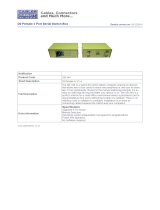
Contents i
Table of Contents
Electronic Emission Statements ...........................................................................vi
Federal Communications Commission (FCC) Statements............................vi
MC/4i, MC/8i, COM/4i, COM/8i..........................................................vi
PC/8i, PC/16i, PC/16e, MC/16i ............................................................vii
Industry Canada Compliance Statements................................................... viii
MC/4i, MC/8i, COM/4i, COM/8i....................................................... viii
PC/8i, PC/16i, PC/16e, MC/16i .......................................................... viii
Introduction ...........................................................................................................1
PC/Xi Boards..................................................................................................1
PC/16e Boards................................................................................................2
MC/Xi Boards ................................................................................................2
COM/Xi Boards .............................................................................................3
Installation Tips.....................................................................................................4
Memory Map Utility ......................................................................................6
User Diagnostics.............................................................................................7
Installing PC/Xi Boards.........................................................................................8
Before you plug in the board..........................................................................8
Jumper Settings.......................................................................................9
J1—Local Program Memory Size ...................................................9
J2 and J3—Dual-Ported Memory Size ............................................9
DIP Switch Settings ..............................................................................10
Memory Start Address—DS1, Switches 1-8.................................10
I/O Port Address—DS1, Switches 9-11.........................................14
Interrupt Request (IRQ) Line—DS2..............................................15
Board Installation—PC/8i............................................................................16
Board Installation—PC/16i..........................................................................17
Installing PC/16e Boards.....................................................................................18
Before you plug in the board........................................................................18
Jumper Settings.....................................................................................19
J1—Local Program Memory Size .................................................19
DIP Switch Settings ..............................................................................19
Board Installation—PC/16e .........................................................................19
Installing MC/Xi Boards .....................................................................................20
Before you plug in the board........................................................................20
Jumper Settings.....................................................................................21
J1—Dual Ported Memory Window Size .......................................21
Other Jumpers................................................................................22
Board Installation - MC/4i and MC/8i.........................................................23





















